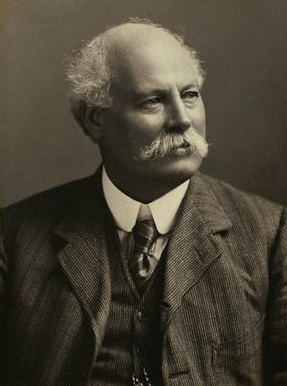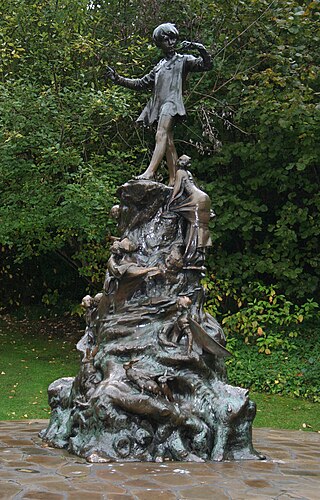
Sir Joseph Edgar Boehm, 1st Baronet, was an Austrian-born British medallist and sculptor, best known for the "Jubilee head" of Queen Victoria on coinage, and the statue of the Duke of Wellington at Hyde Park Corner. During his career Boehm maintained a large studio in London and produced a significant volume of public works and private commissions. A speciality of Boehm's was the portrait bust; there are many examples of these in the National Portrait Gallery. He was often commissioned by the Royal Family and members of the aristocracy to make sculptures for their parks and gardens. His works were many, and he exhibited 123 of them at the Royal Academy from 1862 to his death in 1890.

The Queen Victoria Gardens are Melbourne's memorial to Queen Victoria. Located on 4.8 hectares opposite the Victorian Arts Centre and National Gallery of Victoria, bounded by St Kilda Road, Alexandra Avenue and Linlithgow Avenue.

Kings Domain is an area of parklands in Melbourne, Victoria, Australia. It surrounds Government House Reserve, the home of the governors of Victoria, the Sidney Myer Music Bowl, and the Shrine Reserve incorporating the Shrine of Remembrance.

Melbourne is Australia's second largest city and widely considered to be a garden city, with Victoria being nicknamed "the Garden State". Renowned as one of the most livable cities in the world, there is an abundance of parks, gardens and green belts close to the CBD with a variety of common and rare plant species amid landscaped vistas, pedestrian pathways, and tree-lined avenues, all managed by Parks Victoria.

Sir Thomas Brock was an English sculptor and medallist, notable for the creation of several large public sculptures and monuments in Britain and abroad in the late nineteenth and early twentieth centuries. His most famous work is the Victoria Memorial in front of Buckingham Palace, London. Other commissions included the redesign of the effigy of Queen Victoria on British coinage, the massive bronze equestrian statue of Edward, the Black Prince, in City Square, Leeds and the completion of the statue of Prince Albert on the Albert Memorial.

The fourth plinth is the northwest plinth in Trafalgar Square in central London. It was originally intended to hold an equestrian statue of William IV, but remained empty due to lack of funds. For over 150 years, its use was debated; in 1998, the Royal Society for the encouragement of Arts, Manufactures and Commerce (RSA) commissioned three contemporary sculptures to be displayed temporarily on the plinth. Shortly afterwards, Chris Smith, Secretary of State for Culture, Media and Sport, commissioned Sir John Mortimer to seek opinions from public art commissioners, critics and members of the public as to its future. Mortimer's final report recommended that there continue to be a rolling programme of commissioned temporary artworks rather than settle permanently on one figure or idea.

The statue of the Earl Kitchener is an outdoor bronze statue by John Tweed depicting Herbert Kitchener, 1st Earl Kitchener, installed in 1926 and located on the south side of Horse Guards Parade in London, United Kingdom. The sculpture stands on a Portland stone plinth. It became a Grade II listed building in 1970.

A Grade II-listed bronze statue of Robert Clive, 1st Baron Clive, by John Tweed, stands in King Charles Street, Whitehall, London. The work was unveiled in 1912 outside Gwydyr House, also in Whitehall, and was moved to its current location in 1916.

The South Bank Lion is an 1837 sculpture in Central London. Since 1966 it has stood next to County Hall, on the South Bank of the River Thames. It is a significant depiction of a lion, along with the four that surround Nelson's Column in Trafalgar Square just across the river.

The Offerings of Peace and The Offerings of War are a pair of bronze allegorical equestrian statues by Gilbert Bayes commissioned for the entrance of the Art Gallery of New South Wales. They have been on permanent display since their installation in 1926.

The Thames Ditton Foundry was a foundry in Thames Ditton, Surrey, which operated from 1874 to 1939 and which under various owners produced numerous major statues and monuments as one of the United Kingdom's leading firms of bronze founders.

The statue of Peter Pan is a 1912 bronze sculpture of J. M. Barrie's character Peter Pan. It was commissioned by Barrie and made by Sir George Frampton. The original statue is displayed in Kensington Gardens in London, to the west of The Long Water, close to Barrie's former home on Bayswater Road. Barrie's stories were inspired in part by the gardens: the statue is at the place where Peter Pan lands in Barrie's 1902 book The Little White Bird after flying out of his nursery. Six other casts made by Frampton have been erected in other places around the world.
A statue of Elizabeth II by Leo Mol was installed in Winnipeg, Manitoba, Canada.

A statue of Captain James Cook stood in Victoria, British Columbia, from 1976 until 2021, when it was toppled in a protest. It was a fibreglass copy of a bronze statue of 1912 by John Tweed in Whitby, Yorkshire, England. The Victoria Environmental Enhancement Foundation commissioned the work from Derek and Patricia Freeborn to mark the 200th anniversary of Cook's departure on his third voyage in 1776. The statue was unveiled on July 12, 1976, by William Richards Bennett, Premier of British Columbia. It stood on the Causeway, facing the Fairmont Empress hotel, with its back to the Inner Harbour.
A number of monuments and memorials in Canada were removed or destroyed as a result of protests and riots between 2020 and 2022. These included six sculptures of Sir John A. Macdonald, the first prime minister of Canada, three of other figures connected to the Canadian Indian residential school system, two of Canadian monarchs, one of the British explorer Captain James Cook and one of John Deighton, a bar-owner whose nickname inspired the name of Vancouver's Gastown district.

A bronze statue of the British explorer Captain James Cook stands in Hyde Park, Sydney, Australia. Designed by Pre-Raphaelite Brotherhood sculptor Thomas Woolner and unveiled in 1879, the statue is larger than life and depicts Cook holding a telescope in his left hand with his right hand extended towards the sky.
The Statue of Queen Victoria stands on the sea front at the bottom of Grand Avenue in Hove on the south coast of England. The statue is one of 14 by Thomas Brock and was unveiled in February 1901, the month after Queen Victoria's death. It is a grade II listed building.

Wellington's Queen Victoria Monument is an early 20th-century statue of Queen Victoria by British sculptor Alfred Drury. Copied after Drury's earlier 1903 Portsmouth statue, Victoria is depicted standing triumphantly in her Robe of State and widow's cap, holding a royal scepter and orb. The monument's plinth additionally features a plaque and three bronze reliefs, designed in the New Sculpture style, depicting the Treaty of Waitangi and various artistic and scientific inventions of the Victorian era.
A Statue of James Cook is located by Cooks' Cottage in Fitzroy Gardens in Melbourne. It was originally created by Marc Clark in 1973 and moved to its current location in 1997.
















